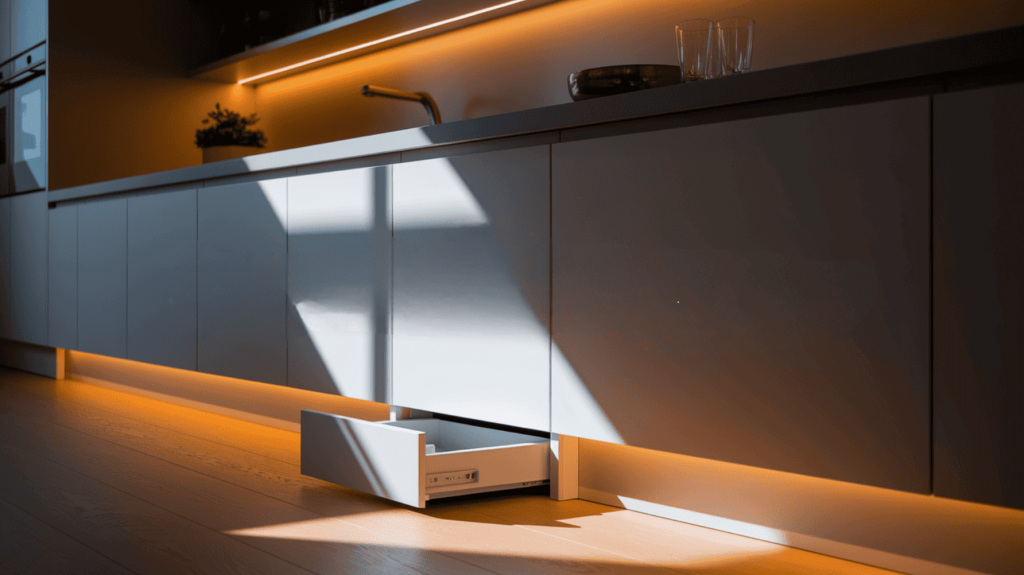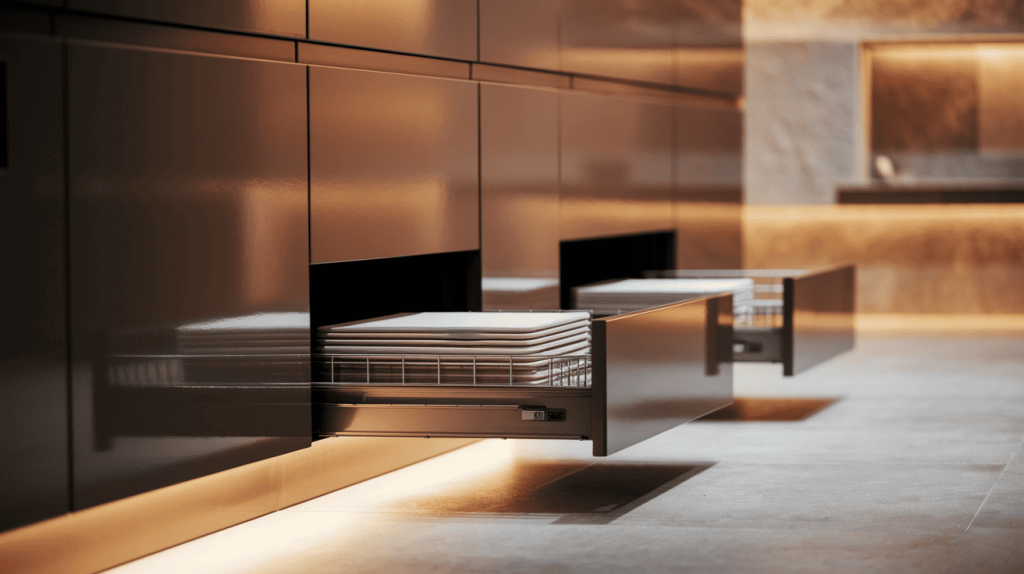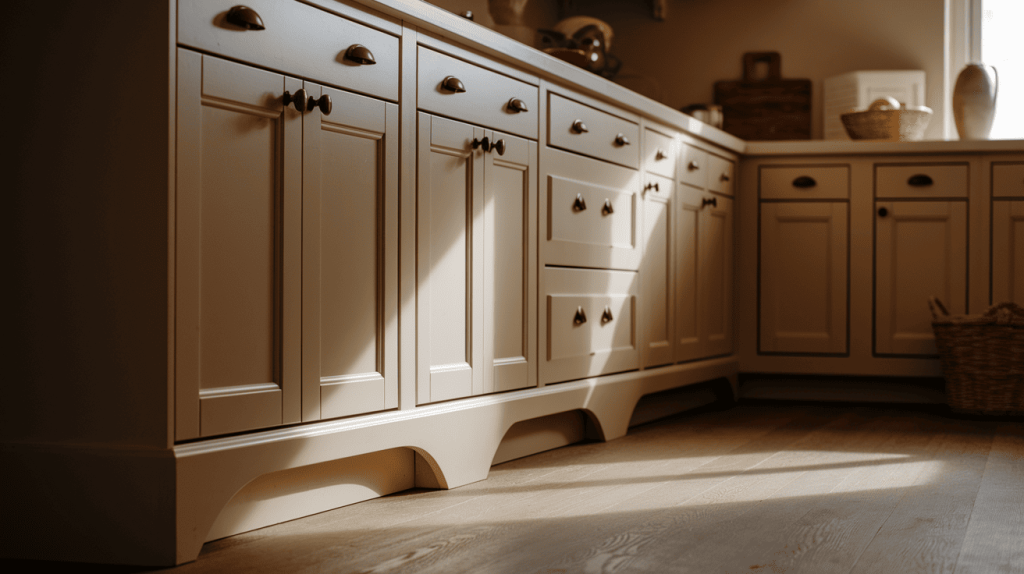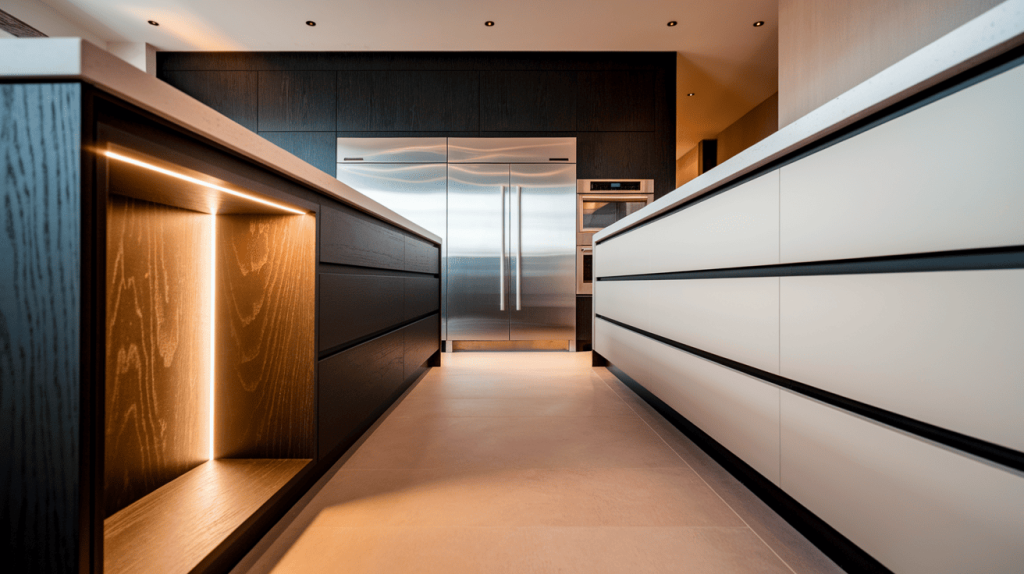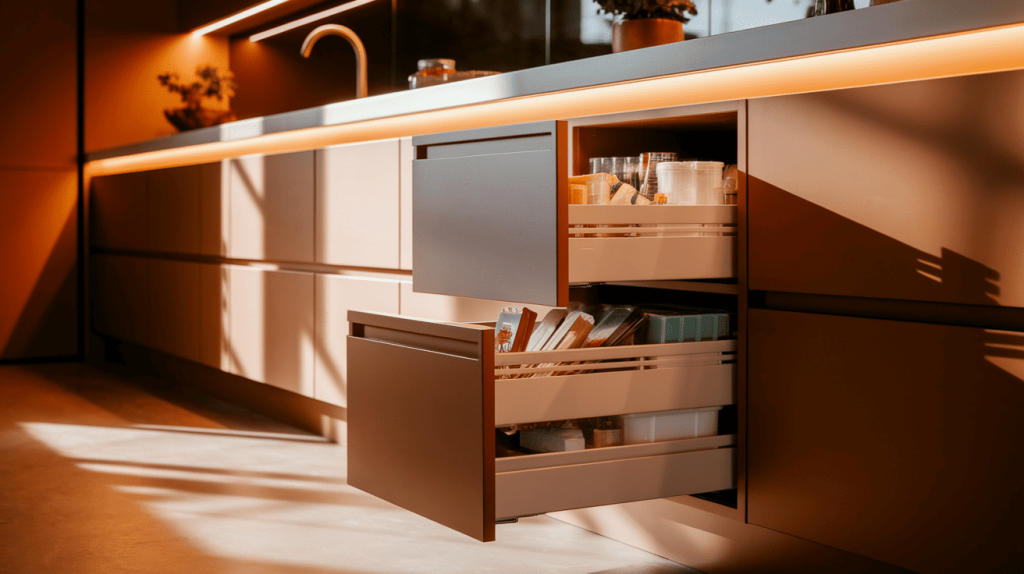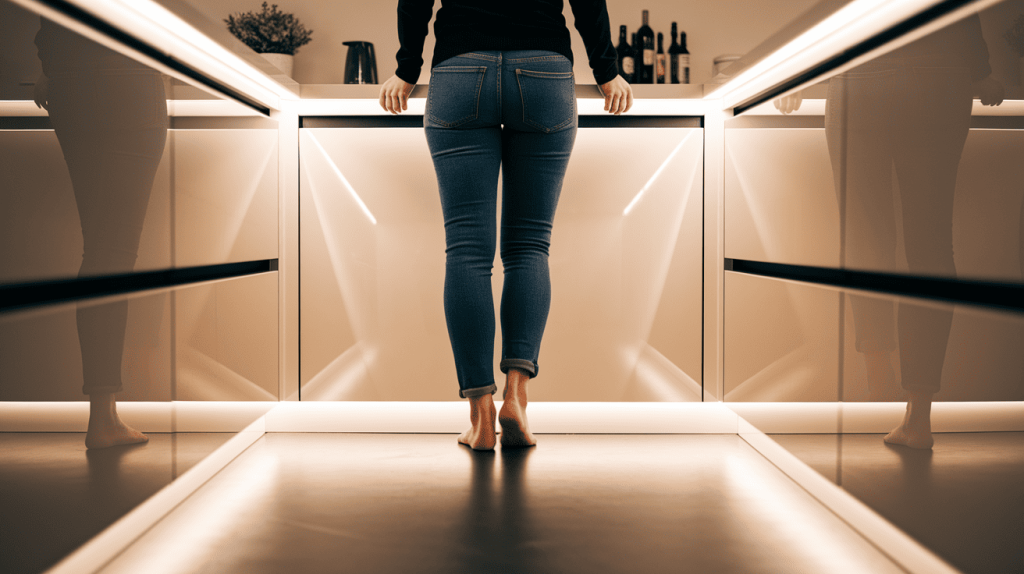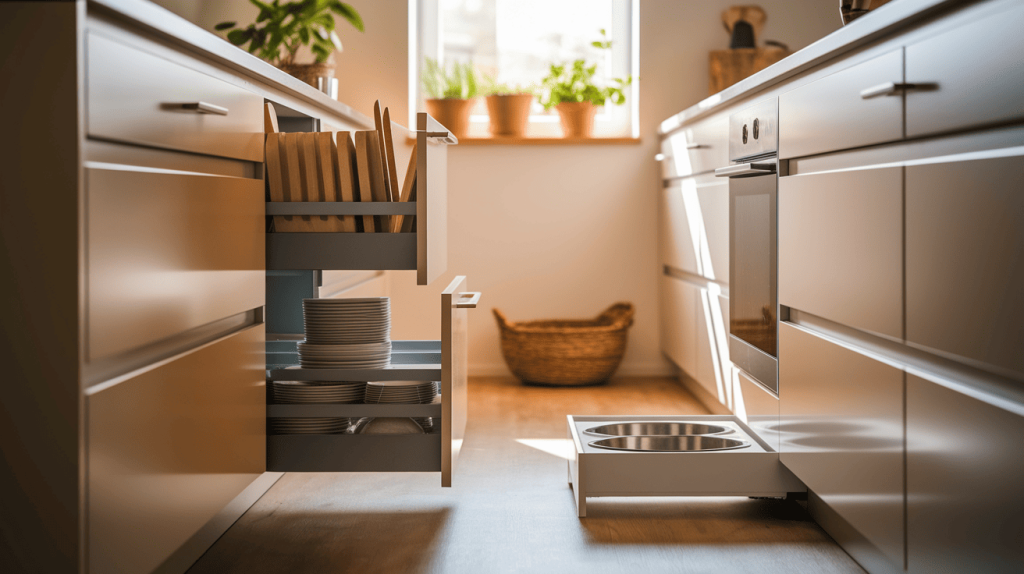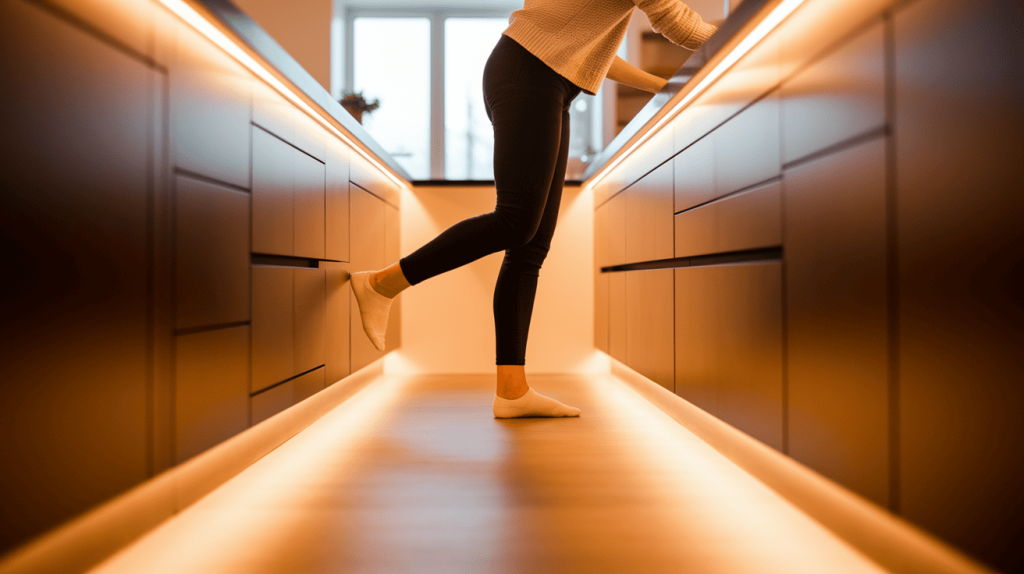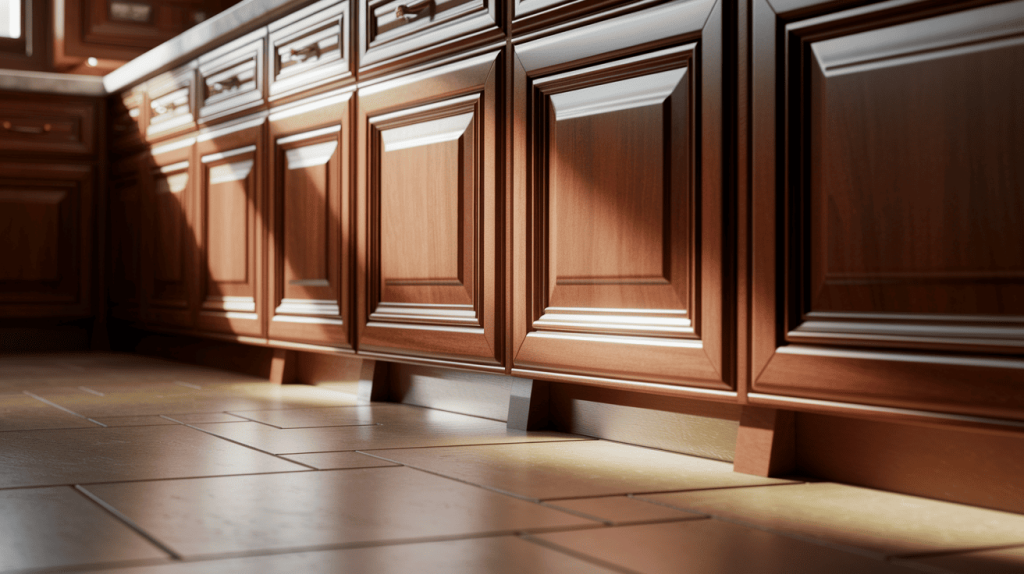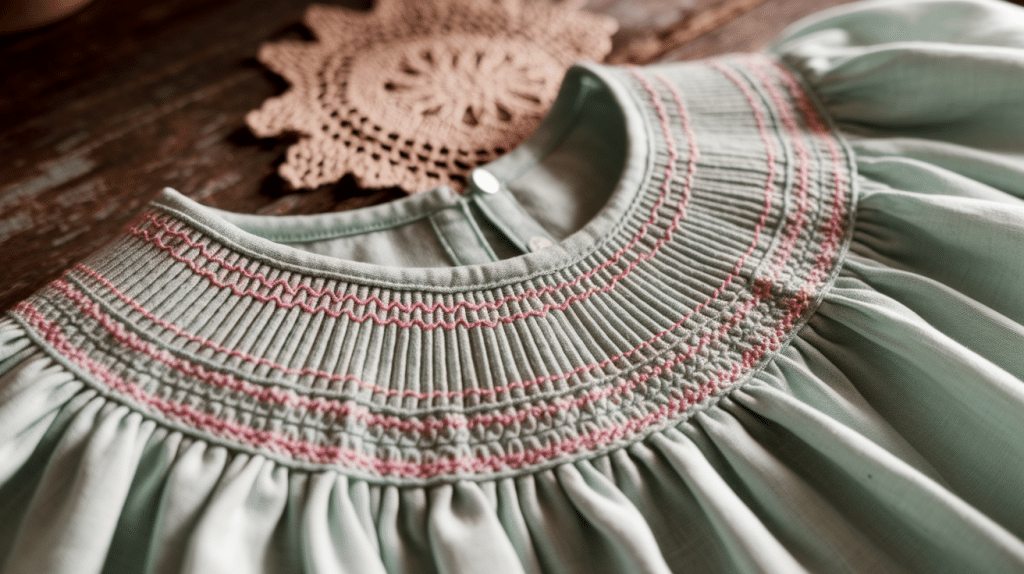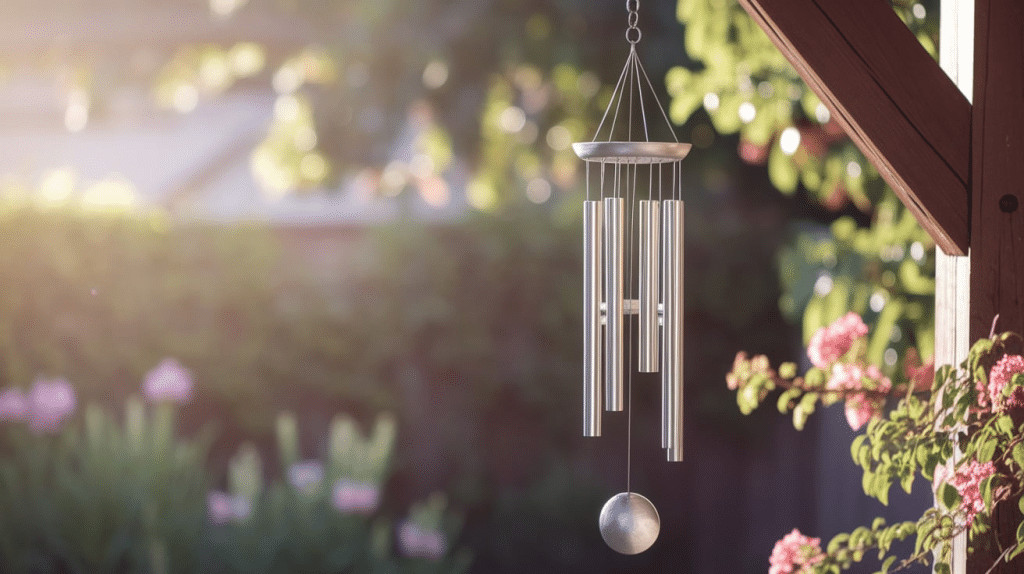Have you ever noticed that little recessed space at the bottom of your kitchen cabinets?
That’s the toe kick cabinet—a small feature with a big impact on your daily kitchen comfort.
These humble spaces do more than just let you stand closer to countertops without stubbing your toes.
Modern toe kicks have evolved from simple recesses to clever storage opportunities that maximize every inch of your kitchen.
From traditional designs to custom solutions with built-in heating, toe kicks combine function and style in ways many homeowners overlook.
Ready to learn how this often-ignored cabinet feature might be the kitchen upgrade you never knew you needed?
Let’s look into the world of toe kick cabinets and why they deserve your attention.
What is a Toe Kick Cabinet?
A toe kick cabinet is the recessed area at the bottom of kitchen or bathroom cabinets that creates a small inward space near the floor.
This clever design feature allows you to stand closer to your countertops without stubbing your toes, making kitchen tasks more comfortable.
Toe kicks are standard in most modern cabinetry and typically measure about 3-4 inches high and 3 inches deep.
Initially, early cabinets were flush with the floor, but as kitchen design evolved in the early 20th century, designers saw the ergonomic benefits of this setback.
By the 1950s, toe kicks became a standard feature in American homes as built-in cabinetry grew in popularity.
Today, toe kicks offer comfort and can serve as functional storage with specialized drawers that use the space beneath standard cabinets.
Why Are Toe Kick Cabinets Important?
Toe kick cabinets play a crucial role in kitchen and bathroom design beyond their simple appearance.
First and foremost, they provide vital ergonomic benefits by allowing you to stand closer to countertops without straining your back or neck.
This recessed space gives your feet room to rest naturally underneath the cabinet while you work, reducing fatigue during lengthy cooking or cleaning sessions.
From a design perspective, toe kicks create a sleek, polished look that makes cabinets appear to float slightly above the floor rather than sit heavily on it.
This subtle detail adds a touch of refinement to any space. Additionally, toe kicks offer surprising storage potential in areas that would otherwise go unused.
By installing specialized drawers or compartments in this space, homeowners can maximize every inch of available storage.
This is perfect for stashing rarely used items like baking sheets, serving platters, or cleaning supplies.
Types of Toe Kick Cabinets
Toe kick cabinets come in various designs to suit different needs and preferences.
From standard recesses to innovative storage solutions, these understated features can be customized to improve the functionality and appearance of your kitchen or bathroom.
1. Traditional Toe Kicks
Traditional toe kicks are the standard recessed areas found at the bottom of most cabinets.
Typically measuring 3-4 inches high and 3 inches deep, these simple cutouts create foot clearance while maintaining a clean look.
They’re usually finished with a matching cabinet base molding or left with a simple flat board.
This classic design works well in most kitchens and has been the industry standard for decades because of its straightforward functionality and timeless appeal.
2. Custom Toe Kicks
Custom toe kicks are specially designed to accommodate unique kitchen layouts or specific needs.
These might feature unusual dimensions, angled recesses, or decorative elements that complement the overall kitchen design.
Homeowners with special requirements, such as wheelchair accessibility, might opt for deeper toe kicks.
Others might choose custom heights or integrated lighting for a dramatic effect.
Some designers even incorporate contrasting materials or colors to make toe kicks a subtle design feature rather than just a functional element.
3. Toe Kick Drawers
Toe kick drawers change typically unused space into practical storage areas.
These shallow drawers fit perfectly into the toe kick recess and can be pulled out to store items like baking sheets, serving platters, or cleaning supplies.
They often feature push-to-open mechanisms that eliminate the need for handles, maintaining the clean look of your cabinetry.
Toe-kick drawers are excellent for maximizing storage in smaller kitchens where every inch counts.
They offer a smart solution for items that don’t require frequent access.
4. Toe Kick Heaters
Toe kick heaters integrate heating units directly into the recessed space beneath cabinets.
These compact systems blow warm air across the floor, creating a comfortable kitchen environment, especially during colder months.
They utilize otherwise unused space while providing efficient supplemental heating exactly where you stand most often.
Toe kick heaters are particularly popular in colder climates. They can be connected to your home’s heating system or installed as independent electric units for targeted warmth without heating the entire house.
Toe Kick Design and Materials
Choosing the right materials and design for your toe kick cabinets affects both the function and the look of your kitchen.
Consider these key elements when planning your toe kick design.
| ASPECT | DESCRIPTION |
|---|---|
| Materials | Wood: warm, paintable Metal: durable, modern Composite: moisture-resistant, affordable |
| Color Options | Match for seamless look Contrast for visual appeal Neutrals for versatility |
| Style Fits | Modern: Sleek, minimal Traditional: Deeper with molding Rustic: Distressed, natural wood |
| Practical Concerns | Dark hides scuffs, shows dust Consider moisture exposure Match durability to traffic |
Remember that toe kicks, while often overlooked, are visible parts that add to your kitchen’s overall impression.
Select materials and finishes that improve your space. Coordinate the toe kick design with your cabinet choices early in planning.
Functional Benefits of Toe Kick Cabinets
Toe-kick cabinets offer more than just a design element, they provide practical benefits that make your kitchen more comfortable, useful, and easy to maintain.
These often-overlooked features can make a big difference in how you use your kitchen every day.
1. Ergonomics
Toe kick cabinets allow you to stand closer to countertops without straining your body.
This small recess lets your feet tuck underneath cabinets naturally, putting less pressure on your back, neck, and shoulders during cooking or cleaning tasks.
Without toe kicks, you’d need to lean forward awkwardly to reach the counter.
This simple design feature helps prevent fatigue and discomfort, especially during lengthy kitchen activities like meal prep or dishwashing, making your kitchen work more comfortable.
2. Storage
Toe kick spaces can be turned into handy storage areas with special drawers that fit into this typically unused space.
These shallow drawers are perfect for items you don’t need every day, like baking sheets, cutting boards, or seasonal serving platters.
Some homeowners use toe kick drawers for pet food bowls that can be pushed away when not in use.
This smart use of space is especially valuable in smaller kitchens, where every inch of storage matters. It helps you make the most of your available cabinet space.
3. Accessibility
Toe kick cabinets make lower storage areas easier to access by allowing you to get closer to base cabinets without bending as far.
This small design feature makes a big difference when reaching into lower cabinets or drawers.
Toe kicks also simplify cleaning. Their recessed design prevents dirt and crumbs from getting trapped in hard-to-reach corners.
Many toe kicks feature a simple design that can be easily wiped clean, making maintenance quick and straightforward as part of your regular kitchen cleaning routine.
Mistakes to Avoid with Toe Kick Cabinets
When planning your kitchen or bathroom cabinets, pay attention to these common toe kick mistakes.
Small details can make a big difference in how comfortable and good-looking your space will be.
- Too shallow toe kicks (less than 3 inches) force awkward standing positions.
- Wrong height causes discomfort (standard is 3-4 inches).
- Mismatching the toe kick style with the cabinet design.
- Failing to seal where toe kicks meet the floor.
- Forgetting to budget for quality toe kick materials.
- Using materials that can’t handle moisture or cleaning.
Remember that toe kicks are both functional and visible parts of your cabinetry.
Taking time to plan them properly will improve comfort and the overall look of your space.
Summing It Up
Toe kick cabinets prove that small details make significant differences in kitchen design.
These modest spaces beneath your cabinets serve multiple purposes – from improving comfort while cooking to adding surprise storage for seldom-used items.
With various materials, styles, and functions available, toe kicks offer both practical benefits and design opportunities for any kitchen.
Paying attention to details like height, depth, and material choices helps avoid common mistakes and ensures long-lasting performance.
Next time you’re in your kitchen, take a moment to appreciate these understated features working silently below your cabinets.
The humble toe kick might be the hidden champion of your kitchen’s comfort and functionality.
The Hidden Power of Toe Kick Cabinets
Toe kick cabinets prove that small details make significant differences in kitchen design. These modest spaces beneath your cabinets serve multiple purposes – from improving comfort while cooking to adding surprise storage for seldom-used items.
With various materials, styles, and functions available, toe kicks offer both practical benefits and design opportunities for any kitchen.
Paying attention to details like height, depth, and material choices helps avoid common mistakes and ensures long-lasting performance.
Next time you’re in your kitchen, take a moment to appreciate these understated features working silently below your cabinets.
Sometimes the smallest spaces hold the biggest potential—your kitchen’s secret weapon is right under your feet!
What clever toe kick solutions have you implemented in your kitchen?
Share your innovative ideas in the comments below!

